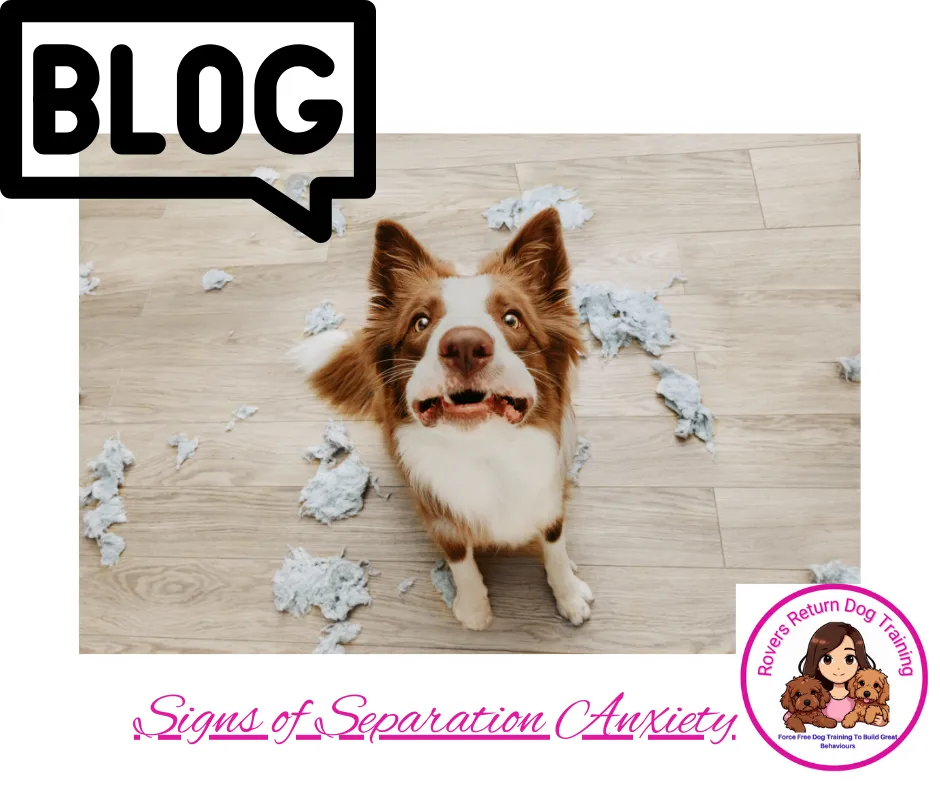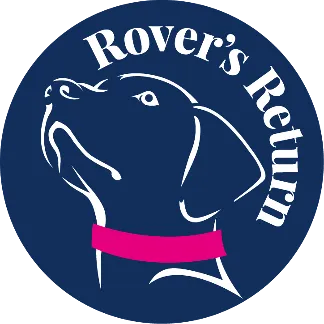Book a FREE 1:1 Assessment Call By Clicking HERE
Specialising In Dog Reactive Behviour
Accredited by APDT, ABTC and UK DOG Behaviour and Training Charter
Qualified and Experienced
Force Free Trainer and Behaviourist
Dog Training Leicestershire Educational Blogs

How to Tell if My Dog Has Separation Anxiety
“Seperation Anxiety is an umbrella term, a better description is seperation related behaviours.” -Sam Hughes

How to Tell if My Dog Has Separation Anxiety
Introduction
As a dog owner, it can be daunting when your dog begins to stress when they think that you are going out. They may follow you around, pant, hide, pace or whine or worse!
These behaviours could be a sign of separation issues in your dogs, a common but distressing condition. It's essential to understand this behaviour and know how to identify it so you can help your dog cope better when they're alone. This blog post will guide you through the signs of separation anxiety and provide some tips on managing this condition.
Understanding Separation Anxiety in Dogs
Separation anxiety is an umbrella term I prefer to call it SRB. Separation-related behaviours.
This is where a stress response occurs when they are left alone or separated from one or more of their owners. They may not even show the classic signs of separation, so it can be hard to tell.
Issues may arise with a person whom they've formed a strong emotional bond with or a genuine fear of being alone, but that doesn’t always mean leaving the house.
This condition can manifest in various ways, ranging from mild discomfort to severe panic attacks. It's not fully understood why some dogs develop separation anxiety while others don't, but factors such as changes in routine, moving homes, or losing a family member can trigger it
Dogs may struggle with change in environments
Single owners were found to be a risk factor
Followed owners around the home
Overexcited greetings
Anxiety when perceiving owners leaving
Dogs coming into a new home
Neutered dogs were 95% more likely to display SRB

Signs of Separation Anxiety
Recognising the signs of separation anxiety is the first step towards helping your dog manage their stress. Here are some common symptoms to look out for:
1. Destructive Behaviour: If your dog becomes destructive only when left alone (chewing furniture, scratching doors), this could be a sign of separation anxiety, it can be difficult to know when it is due to boredom. Separation destruction can be severe as they are desperate. They may try to escape or cause severe damage.
2. Excessive Barking or Howling: Dogs with separation anxiety often bark or howl excessively when left alone. This generally happens straight away and not later. If they vocalise later in the day it is likely due to boredom.
3. Pacing: Some dogs walk or trot along a specific path in a fixed pattern when left alone or separated from their owners.
4. Accidents Indoors: Even well-trained dogs may urinate or defecate inside the house when experiencing separation anxiety.
5. Attempted Escape: In severe cases, dogs with separation anxiety might try to escape from areas where they are confined when left alone or separated from their owners.
6. One key aspect of SRB is that they do not eat or drink when left alone
7. They don’t rest. When suffering the dogs will not be able to settle or rest.
Analyzing Dog Behaviour
It's important to note that these behaviours can also be signs of other issues, so it's crucial to observe your dog's behaviour. For instance, if your dog only chews things when you're not around, it could be a sign of boredom rather than separation anxiety. Similarly, accidents indoors could be due to medical issues or inadequate house training. Therefore, it's essential to rule out these possibilities before concluding that your dog has separation anxiety.
If you're unsure about your dog's behaviour, consider setting up a camera to monitor them when you're not home. This can provide valuable insights into their behaviour and help you determine whether they have separation anxiety or if there's another issue at play.
If your dog suddenly becomes anxious, it could be linked to pain or illness so get that checked out.
Anxiety Treatment for Dogs
If you've determined that your dog is indeed suffering from separation anxiety, there are several approaches you can take:
1. Training and Conditioning: Gradually acclimating your dog to being alone will be required, at some stage. However, working on your movement and not leaving them alone is an essential step before they can begin to cope with being left alone. Starting by leaving them alone for short periods and gradually increasing the duration over time will likely lead to failure if you don’t work on the micro triggers of the dog predicting your movement means going out!
2. Medication: In severe cases, medication may be helpful. Always consult with a vet before giving your dog any medication. However, it should be used in conjunction with a behaviour plan as it cannot be a long-term strategy.
3. Professional Help: If your dog's separation anxiety is severe consider seeking help from a professional animal behaviourist. Rovers Return Dog Training offers a free call to discuss your issues
4. Provide Distractions: This is often given as advice for SRB, however, keeping your dog busy while you're away will not reduce anxiety but will help boredom. Consider toys that require mental stimulation or treats that take time to consume if your dog is bored.
Conclusion
Separation anxiety in dogs can be distressing for both the pet and the owner. However, by understanding the signs of this condition and taking appropriate steps towards treatment and management, it is possible to alleviate the symptoms and improve your dog’s quality of life significantly.
Remember that every dog is unique; what works for one might not work for another. It may take some time and patience to find the right approach for your dog. Always consult with a professional if you're unsure or if your dog's anxiety is severe. With the right help and support, your dog can learn to cope with their anxiety and live a happy, healthy life.
Highly Qualified Behaviourist
Accredited by APDT, ABTC and UK DOG Behaviour and Training Charter
Accredited Scentwork Instructor
Force Free Trainer and Behaviour
Force Free Trainer and Behaviour
Accredited Scentwork Instructor
Accredited by APDT, ABTC and UK DOG Behaviour and Training Charter
Highly Qualified Behaviourist
Contact Us
Sam: 07725 802995
You can contact us via Live Chat button at the bottom of the screen or the contact box to the right.
You can also book one of our services online using the View Dates buttons under the service you require.
© 2023 by Rovers Return Dog Trainers Academy - Force Free Dog Training Lutterworth, Broughton Astley, Leicestershire, Hinckley, Nuneaton, Stoney Stanton, South Kilworth, Ullesthorpe
Privacy Policy | Terms and Conditions | Terms and Conditions of Services | Sitemap


Facebook
Instagram
X
LinkedIn
Youtube
TikTok